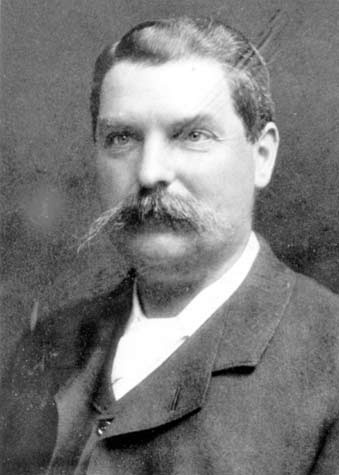 Born in Brixton, London as
one of five children, Emilius Alexander Young was trained as a
hard-headed accountant and was hand picked as an accountant of
the quarry by Lord Penrhyn himself. Under Arthur Wyatt the quarry
was not a picture of efficiency, and on his resignation, Young
took over his duties. In September 1887, J.J. Evans resigned
as executive manager and Young was appointed General Manager.
Born in Brixton, London as
one of five children, Emilius Alexander Young was trained as a
hard-headed accountant and was hand picked as an accountant of
the quarry by Lord Penrhyn himself. Under Arthur Wyatt the quarry
was not a picture of efficiency, and on his resignation, Young
took over his duties. In September 1887, J.J. Evans resigned
as executive manager and Young was appointed General Manager.
In order to clear the tons of slate that had piled up on the
quays at Porth Penrhyn, he set out to seek new markets, travelling
extensively himself. His motto was efficiency and in order to
achieve this every outmoded working practice had to be swept away.
Neither did he hold any truck with unionism in whatever form. In
this, both he and his master were in full agreement. Indeed, Penrhyn was quite happy to leave the whole concern in Young's
hands, and increasingly spent more and more time at his mansion
at Wicken or at Mortimer House, London.
An often heard story in Bethesda at the time was that the financial
state of the quarry was so parlous by 1886 that Turquand &
Young lent vast sums of money to the second Lord Penrhyn and that
E.A. Young was determined to recoup every farthing with as much
interest as possible. Could part of Young's terms of employment
have been that the running of the quarry was vested in his hands on
Lord Penrhyn's behalf? Could this explain, that apart from one
instance, every poster from the quarry office from 1886 onwards
(apart from one) has Young's name at the bottom? Prior to 1886,
every poster was signed Penrhyn.
Another interesting fact was that on the death of the estate
agent, Sackville-West in 1889, all his shipping interests went to
Young rather than to the second lord. Young now owned five
steamers and one three-masted schooner and had a stranglehold on
the slate trade in and out of Porth Penrhyn, by ensuring that his
ships had priority at all times. On his death in 1910, these
interests were inherited by his widow, two of his sons and
probably his son-in-law. These interests were sold to the third
Lord Penrhyn in 1911.
Living at Tan-y-bryn, in a completely English-speaking cocoon,
he employed seven servants, as well as a nurse and under nurse to
look after his children. Indeed, Tanybryn was more anglicised
than Penrhyn Castle. He was full of good works towards
nursing associations and health matters in the area, including the
quarry hospital. He was also a warm supporter of all church matters as
well as the North Wales Training College. He arranged many
concerts and contributed greatly to enable the Penrhyn Male Voice
Choir to compete at the Chicago World Fair in 1893. Even though
the choir only came second, Young presented every member with a
framed photo of himself on their return.
One wonders how many if any survived the Great Strike?